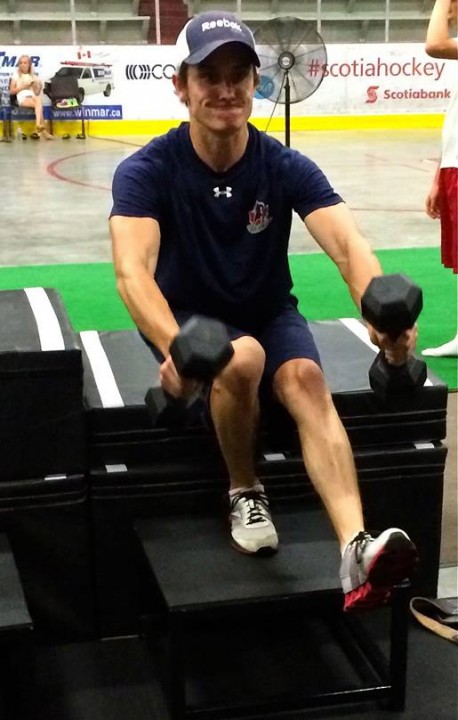The Proper Way To Train In-Season

Ross Krieger, who plays for the Dresden Kings, has started his in-season training with Athletes’ Fuel. Here he does a 1-leg squat – Contributed Photo
In-season training is meant to support skill development in your respective sport by improving physical qualities in training, that will not significantly interfere with the quality of your play in practice and games.
I hear it every now and then from a parent; “my kid doesn’t even look tired when they’re finished training!” That is the point! This is what is wrong with training in-season as we as a sporting culture view it. We need to stop equating “sore and tired” with good training, as neither of these things are requisites for improvement. Having said that, there are times throughout the season when my athletes will definitely be sore and/or fatigued from training, but this is more the exception than the rule. The goal is to minimize fatigue and soreness, while still creating a positive adaptation, so athletes can continue to develop in their respective sport.
There are times when athletes do train before practice. This is perfectly fine, and in my opinion even encouraged, when done properly. The misconception from coaches and parents is that if their team/athletes are training before practice, they will be useless at practice because they will be fatigued from training and won’t be able to practice at a high level. If this is the case, then the training parameters have been butchered. I have many athletes that train before practice, and feel better when they left training vs. when they came. They go to practice rejuvenated, and if you ask them, they feel like they have more spring and energy in their legs. It’s a process called post-activation potentiation. In simple terms, we have essentially “woken up” their nervous systems and muscular system without frying it.
Here are some keys that will help you establish the proper type of training for optimal adaptation to occur in-season.
1. Volume/Intensity
In-season training shouldn’t have near the overall volume that off-season programs should have. Recovery for games is the #1 goal of in-season training. Too much volume during in-season training will not allow for full recovery. Volume is the main driver for muscle soreness and fatigue, so decrease overall volume 40-50% vs. off-season volume.
In terms of intensity (load/weight on the bar), this is the one indicator that shouldn’t be reduced. While we do program deload weeks and recovery phases depending on the time of the year in-season, we don’t want to sacrifice intensity to continue to build strength, which is a precursor for power and speed. Intensity doesn’t make you sore; volume does!
2. “Big-Bang” Lifts
I’m not a big proponent for significant changes in exercise selection, especially in-season. In fact, the last variation I make in our athlete’s programs is changing exercises. Instead, we make subtle manipulations in other factors that allow adaptation to occur to avoid stagnation and overtraining. Especially during the season, we keep with our big-bang exercises; those that present us with the best bang for our buck. I only see athletes for ~2 hours per week in-season, so it’s paramount that we keep things familiar, simple, and consistent.
3. Conditioning
Training should compliment skill development in sport; it shouldn’t compete with it. This is one of the reasons we do little to no direct conditioning in-season. My approach is that we want to only hit stressors that are not already present in sports. All sports in-season require conditioning, which is developed by simply playing games and going to practice. Developing the energy systems is movement-specific. If you’re playing your sport 3-4 times per week there is plenty of opportunity to get accustomed to the demands of the game, and your body will naturally adapt to the conditioning needed for your sport.
4. Mobility
Training properly is never only about improving physical qualities (ie. strength, power, speed). It’s also necessary for taking care of your body; avoiding non-contact related injuries such as hip flexor, quadriceps, adductor, and hamstring strains. The season is long and joints take a beating from the repetitive movements displayed in sport. Continually being in the same postures puts you at risk for muscle imbalances and a lack of joint integrity. Along with performance enhancement, we look to address these issues by undoing what the sport does to the athlete. This is why I’m not a fan of “sport-specific” training, particularly in-season. Maintaining your joint mobility and tissue quality is a must. It’s the one thing that athletes that are young don’t want to do, but are required for good health in-season. No one gets better injured. The little time it takes to address these issues will save you long-term.
Your priority in-season needs to be your sport. Prepare yourself by training in your off-season prior to your sport season. Develop your body for the demands of your sport. During the season, focus on developing your skills. Training should take a back seat to your sport in-season, but it should still be present consistently in your weekly preparation to get better.
Wishing all athletes the best of luck in-season. If you need help on establishing the proper in-season programs, you can contact us by email at athletesfuelsc@gmail.com, or by visiting our website at www.athletesfuelsc.com.



Great article!